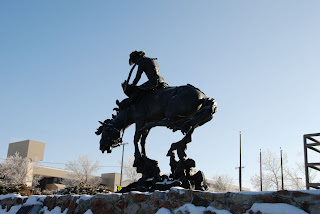In 1864 a group known as the “Four Georgians” (John Cowan, Daniel Jackson Miller, John Crab, and Reginald, or Robert Stanley) stumbled upon gold in what is now Helena's main street. The claim was staked and named “Last Chance Gulch.” (A gulch is a deep V-shaped valley).
As the gulch began to fill with people, the miners decided they needed to come up with a name for the town. The “Four Georgians” originally named it Crabtown, after John Crab. Searching for a new name, the miners decided on a name of a town in Minnesota, pronounced Saint Hel-ee-na. Over time, the pronunciation changed to Helen with an "a" on the end and “Saint” was dropped from the name.
In 1875, Helena became the capital of Montana Territory. When Montana became a state, the fight for the location of the state capital began. Helena won, and in October 1898, ground was broken for the State Capitol Building .
The historic downtown area of the capital city is situated in a steep gulch with parts of the city perched on surrounding hillsides. This picturesque setting opens up into a wide valley to the north. On the upper-eastside sits Montana's State Capitol. It seems strange that we are in awe of these magnificent buildings when we used to see them all the time in the UK, but it is nice to see.
Helena's glorious past can also be seen in the spectacular 19th-century mansions, which are absolutely huge. Some of the architecture would not look out of place in the UK.
The St. Helena Cathedral is an imposing building. It is modelled after the cathedral in Cologne, Germany, and is a replica of the Votive Church in Vienna. The twin spires rise 230 feet above the street.
This is the original Governor's Mansion, constructed, in 1888. It contains 20 rooms and seven fireplaces, all restored to turn-of-the-century elegance and furnished with antiques. We did not manage to get on a tour of the mansion this time, but hope to on another occasion.
The Montana Museum houses one of the country's most important collections of Charles M. Russell, a well known artist in the US and Canada.
The museum is quite large, and we didn't manage to get around it all, but for $5.00 each and the option to go back for a second day, free of charge, it is very reasonably priced. It covers history from the first nations, building of the railroads and hotels, to the gold rush and much much more.
This is a model of the bufallo jumps.
Standing face to face with this bear sends a shudder down your spine, even though we know he isn't about to pounce!
This, even more soA buffalo
At -19, it was just the day to wear a Buffalo skin, just like the First Nations people did in the past. It feels about the weight of a Bufallo as Jan staggered around under the weight of it.This is a rare White Bison (not Albino as it has some dark hair, horns and eyes). Only one white bison is born in every half million births.
Outside the museum, there is this statue depicting western culture.
And this 2 and a half ton metal bison skull which is 24 feet wide and 7 feet high.
We feel as though we have only scratched the surface on this visit and we very much look forward to returning at some point in the future.
Over the days ahead, we'll publish some pictures from our tour of the State Capitol building and then some coverage of our return to Canada.
J&E






























